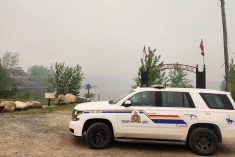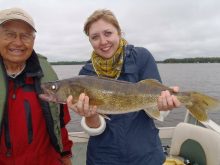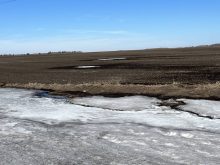Contrary to reports last week, governments have not ruled out additional assistance through AgriRecovery for flooded Prairie farmers, an official with Agriculture Minister Gerry Ritz’s office said Monday.
However, it’s not officially on the table either — at least not yet.
The minister’s office was busy trying to clarify reports emerging from a July 18 press conference with Ritz and provincial agriculture ministers following their meeting in Winnipeg last week.
Those reports, based on comments made at the press conference, indicated AgriRecovery was not being considered in lieu of enhancements made to crop insurance and other disaster assistance programs.
Read Also

Thunderstorms and straight-line winds
Straight-line winds in thunderstorms can cause as much damage as a tornado and are next on our weather school list exploring how and why severe summer weather forms.
“Well, there are a number of programs that will address the flooding. The DFAA (Disaster Financial Assistance Arrangements), PDAP (Provincial Disaster Assistance Program), the province and the federal government, Saskatchewan, Manitoba and the federal government will be having discussions on what’s the best way forward in that,” Ritz told reporters.
“Farmers know they are well served by the programs that are there,” said Ritz, adding improvements were made to risk management programs following the 2011 flood.
“The big change between 2011 and this flood is that unseeded acres and flooded acres are now covered under crop insurance,” he said. “So it’s much more bankable and predictable and stable than waiting for an ad hoc payment under something like AgriRecovery.”
However, the minister’s aide later said the minister was actually responding to a question about additional support for producers affected by multi-year losses related to one year’s flood.
There are no provisions within AgriRecovery to cover multi-year losses resulting from one disaster, Ritz said. Following the 2011 flood, some Manitoba farmers saw water linger on their land, making seeding impossible in 2012. They want to be compensated for that lost year, especially where flooding was caused by diverting water away from urban centres like Winnipeg.
In the past, the federal government has been adamant that AgriRecovery is not intended to pay for the same flood more than once, while provincial officials have been equally fervent in stating that discussions with the federal government are ongoing.
Ritz confirmed the two levels of government are still talking. “There’s been discussions, but I wouldn’t say it’s moving very far, very fast to change that,” said Ritz.
Ron Kostyshyn, Manitoba’s minister of Agriculture, Food and Rural Development, said the province will continue to discuss the issue of multi-year compensation with the federal government both for 2011 and 2014 flooding.
In the meantime, the province is speaking to “a whole gamut of stakeholders” to determine the final impact current flooding will have on the agricultural sector in Manitoba, said Kostyshyn.
Under AgriRecovery, there is a six-step process for determining whether a payment is warranted, beginning with the province requesting an assessment of the disaster.
A joint assessment is undertaken by governments into the scope of the disaster, what producers need, what’s available through existing programs, and whether further assistance is warranted.
At that point, governments determine whether to initiate a joint response through AgriRecovery.
Doug Chorney, president of the Keystone Agricultural producers, said he too was under the impression governments have ruled out using AgriRecovery to offer additional assistance for this year’s flooding.
“I was hoping to see that they were planning to have a robust, strong AgriRecovery program that would get producers through this difficult time, and we didn’t hear that,” he said. “I know this is going to be devastating for producers.”
More than a million acres of cropland had already gone unseeded in Manitoba prior to recent flooding. Chorney estimates that an additional 3.5 million acres have now been lost to high water.
“I think our numbers are solid,” Chorney said, adding he hopes that government changes its tune when it has more information about the number of acres lost.
The province hopes to know the exact cost of the flood in the coming weeks.
Kostyshyn said the province is working to affect flood mitigation works that prevent this kind of flooding in the future.
“This kind of flooding is truly untraditional, but maybe that’s the changes to the weather patterns and maybe we have to live that as the norm,” he said.



















